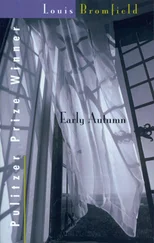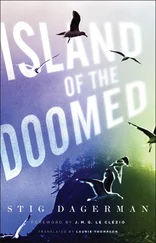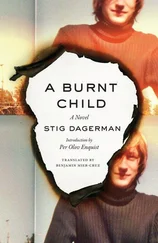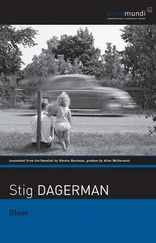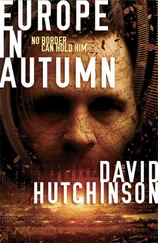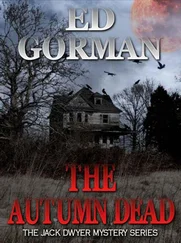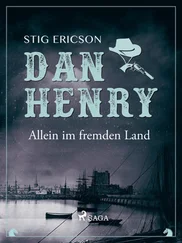I
A Sunday in early winter in Munich, with a cold sun. The long Prinzregentenstrasse, from which one of the unhappiest heroes of world literature once started his journey towards death in Venice, lies deserted in the frosty morning light. There is nothing in the world so deserted and lonely as an empty main street on a cold morning in a bombed city. The sun glitters on the gold of the angel of peace, the angel of peace which divides Prinzregentenstrasse into two monumental gradual slopes down to the bridge over the Isar and which Hitler should have been able to view from his house on Prinzregentenplatz. The gardens in the old ambassadorial palaces lie full of tumbled pillars. On the newly frozen ice of the sports arena a few early-morning Americans are skating, but die grüne Isar is green as usual and far down under the bridge some bombs have made a jigsaw puzzle out of a pond.
The dirty Jeep lurches along the endless street. The severe-looking government building is there, between well-roasted façades of ruins; that is where Minister-President Dr Högner spends several hours a day playing with the idea of letting Bavaria renounce its connection with the rest of Germany, according to a theory which says that Prussia has twice brought Bavaria to a state of ruin and should not be allowed the chance of doing so a third time. Bavaria, cold-bloodedly sending evacuees from Hamburg, Hannover and Essen back to the total impossibilities of their native cities, is of course a selfish, hard-hearted and tough region, but that is not the whole truth. At least a quarter of the truth is that Bavaria has no feeling of belonging to the rest of Germany and that — in spite of a general belief to the contrary — there was a not insignificant degree of passive resistance to Nazism in Bavaria.
But not far from Prinzregentenstrasse lie the ruins of the Brown House. The first bloody Hitler putsch was played out in Munich in 1923 and the remains of Bürgerbräukeller still testify that the history of Nazism has deep roots here. No doubt, says the humorous native of Munich, but perhaps that is because of the föhn in spring, that wind from the mountains which gives the whole of Munich an intolerable month-long headache; he points out too that after the Nazis had made it compulsory for pedestrians to bare their heads as they passed Feldherrenhalle, where the memorial to the sixteen victims of the putsch was set up, the density of the pedestrian traffic in that once so thronging part of Munich noticeably diminished.
On Prinzregentenstrasse lies too die Export-Schau, accommodated in one of those sexless pseudo-classical Hitler buildings which do not look ancient until they are ruins. The Export Exhibition is a sadistic arrangement where the city authorities, with a remarkable psychological insight and for an entry fee of one mark, display what Bavarian industry can achieve, that is, what Bavarian industry can export to America. There, bombed-out housewives can look at fine dream-like porcelain they will never eat off; big bottles stand full of real German beer which one can no longer drink; and lengths of splendid fabrics hang which one is forbidden to touch. For anyone poor and hungry this must feel like landing up in a disastrous dream, where everything is certainly unreal as in a dream, but where the dreamer is constantly aware of his own hunger and his own poverty.
II
A few minutes away from Prinzregentenstrasse is Königsplatz, that desert built by the architects of Nazism, which more than most other examples of the type reveals the lack of style, the desolation and the patent sadism of the Nazi ideals. One enters through narrow openings in a broken triumphal arch or between the two elevated marble tombs of the sixteen Munich martyrs, where their zinc coffins, eight in each grave, lay buried until the Americans on their arrival moved them to an unknown alternative site. The former graves are flanked by two huge palaces, characteristic buildings of the Hitler period, that look like mausoleums in honour not of any particular death but of death itself as a principle. In one of these mausoleums the Munich Agreement of 1933 was signed. At that time the triumphal arch was still whole and it is easy to close one’s eyes and imagine how the cavalcade of the signatories’ cars came through the arch and in a gentle curve over the square approached the monumental tomb-like buildings, where for the moment the world’s destiny lay buried, and today on this cold morning in early winter something is going to happen which for an hour or two will conjure the dead from their graves.
Below the triumphal arch a brass band is assembling. The cold sunlight glitters from the instruments, the breath from the mouths of the players is white. You walk across this endless square, whose surface of huge ashlar stones gives a curious impression of being indoors, into the vast entry-hall of the locked castle like those we have dreams about. The heavy American lorries sweeping along the white traffic-ways in under the arch appear quite unreal in these surroundings. A few hundred stamping and shivering people have gathered before the band; there is an American woman correspondent in uniform, one of those strange creatures who seem to have been born wearing a camera; two lorries have driven round behind the band in such a way that standing there back to back they form a platform for journalists and speakers. A steady stream of people is flowing in, and by ten o’clock ten thousand stand waiting.
The band plays a march, sounding rough in the cold. The journalists of Munich sharpen their pencils, representatives of those remarkable and courageous papers that largely without telephones or typewriters or offices still manage in some mysterious way to appear, printed in cellars ankle-deep with water on rainy days (the printers having to wade about in Wellingtons) — those same newspapers that, comically, at the wish of the Americans are ‘above party’, which has meant that more than one confused Herr Müller has read in the Monday edition of his local chronicle a Social Democrat leader prescribing the greatest suspicion towards the Christian Socialists, and then on Wednesday in the same chronicle a Christian Socialist leader exhorting readers to watch out for the Social Democrats, and then on Friday, still in the same chronicle, a Communist leader issuing an urgent warning against both the Social Democrats and the Christian Socialists.
So, the journalists are sharpening their pencils, in the loudspeakers one man welcomes another man, the voices die away and the music falls silent. A man who has taken off his overcoat rises and walks stiffly over the platform. The silence intensifies even further, something of the tension before a revolver shot about to be fired trembles in the cold air above Königsplatz. The man behind the microphone is Dr Kurt Schumacher, leader of the German Social Democrats.
Then when he starts speaking the spell breaks. We can see why he took off his overcoat. Dr Schumacher is a speaker who can talk in his jacket in a temperature of minus ten without feeling cold. At the Kästner Cabaret in Schau-Bude there is a Schumacher caricature: a new Führer who waves his arms and howls with the same hysteria as the old one. The caricature is inaccurate to the extent that its new Führer has two arms. Dr Schumacher has only one but his manner of using it is fascinating. And it is not quite true that Dr Schumacher screams. The impression he makes is due rather to his restrained passion, his sulkiness, the absolute lack of sentimentality in his tone, which allows him to utter sentimentalities that sound like bitter truths, and his sour crossness, which can so easily be taken for reliability and which sometimes allows him to tell half-truths that sound like whole-truths.
Читать дальше

